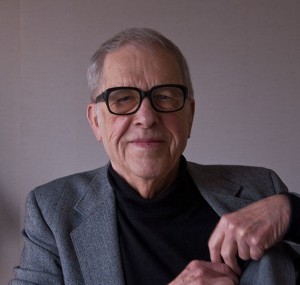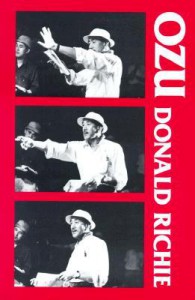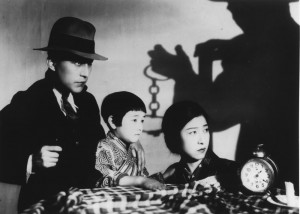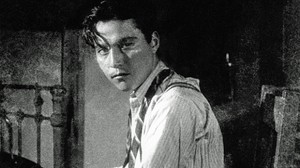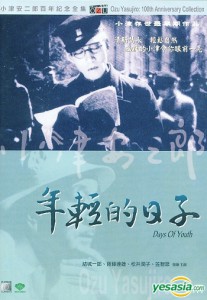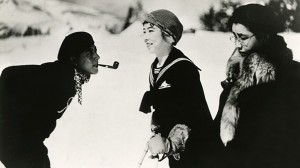From the Summer 1975 issue of Sight and Sound. Due to the length of this piece, I’m running it in three parts. I’ve hesitated for years about reprinting this because of its harshness towards the very amiable and sweet-tempered Donald Richie (1924-2013), whom I eventually met and befriended in Tokyo a quarter of a century after writing this piece (and who generously forgave me for having written it after I offered an apology). Even though I can’t say I agree with everything I wrote here — I’m especially dubious about some of Burch’s arguments (and many or all of the passages I quote here from To the Distant Observer, which he was writing at the time, subsequently got edited out of the manuscript) — it holds up better than I suspected it would, which is why I’m posting it here. I tend to think now that the failings of Richie’s book on Ozu are more institutional than personal — that is, a reflection of his unfortunate virtual monopoly on critical discourse in English about Japanese cinema during that period. — J.R.
A few years ago in New York, a lecture by Henri Langlois was announced at the Museum of Modern Art under the rough heading — I quote from memory — of ‘Why We Know Nothing About Cinema’. When this imposing archivist took the podium, he started off by wryly noting that this title was a misnomer; he was a victim of false advertising, and disappointed patrons should repair at once to the box-office for a refund. ‘I’m very sorry,’ Langlois explained, ‘but I don’t know why we know nothing about cinema.’
Detailed criticism of the Japanese cinema is for obvious reasons a task that most Western critics shy away from (one reason, perhaps, why we still have no extended study of Mizoguchi in English). Given this situation, Donald Richie occupies a privileged position in relation to his subject that is virtually unparalleled in film scholarship; on a great many matters, he cannot even be appraised merely trusted or not trusted. He is usually trusted. ‘The definitive history,’ Dwight Macdonald wrote of Joseph L. Anderson’s and Richie’s The Japanese Film (1959) in 1966, neglecting to mention that it also happened to be the only one, at least in English. By and large, Richie’s subsequent books have been accorded comparable receptions, and have served as basic scaffolding for most other works on related subjects.
In many crucial respects, Richie’s Ozu (University of California Press, 1974) is substantially the book that devotees of the director have been waiting for: a full-length critical work about Ozu’s life, career and working methods, buttressed with reproductions of pages from his notebooks and shooting scripts, numerous quotes from co-workers and Japanese critics, a great many stills and an unusually detailed filmography. It is an impressive array, but also a rather deceptive one. By ostensibly filling in the gaps, of what has remained, in the West, an incomplete and uncertain picture of a singular Japanese master, Richie is primarily concerned with resolving certain issues and problems; insofar as it is feasible, he appears to be giving us Yasujiro Ozu ‘whole’, as a coherent, consistent and legible entity. But in the course of his efforts, this ‘whole’ becomes a Procrustean bed -– raising other issues and problems that relate not only to Ozu but to Richie’s methodology, and the critical tradition it largely reflects.
Unlike Richie, I am not an Ozu scholar and have no speaking knowledge of Japanese.Out of the thirty-odd Ozu films that exist today (nineteen of twenty more are lost), I have seen twenty, many without any sort of translation. A recent opportunity to see or resee half of these has afforded me a chance to ‘test’ Richie’s book for its usefulness and accuracy in certain areas, and the results — some of which are detailed below — have not been altogether encouraging. It is an open question whether we would know very much at all about Ozu today without Donald Richie. It is unquestionable that most of what we do know comes from two sources: the films of Ozu that are available, and Donald Richie. That we nevertheless know very little, and a lot less than we conceivably might, about Ozu, is the essential point of these remarks.
***
Problem No. 1: Much as Ozu repeated certain plots and dramatic situations many times over the course of his career, Richie has repeated certain adages about Ozu endlessly. On the copyright page of Ozu, we discover that ‘Portions of this book originally appeared in Film Quarterly, Film Comment and Eiga Hyoron, as well as Shochiku and New Yorker film catalogues, and programme notes for ‘The Museum of Modern Art, New York, Cinema 16, and The Boston Museum of Fine Arts,’ which helps to explain why so much of the book has a familiar ring; we’ve been reading it for years. Nor is this list complete: portions of the text have also figured in The Japanese Film, Japanese Movies (1961), and Japanese Cinema (1971).
Occasionally the phrases are altered slightly as they crop up insistently over the years, but there is seldom evidence of rethinking. The ‘man on the street’ in The Japanese Film ‘who will say of a new Ozu film: “That picture really has the Japanese flavour”‘ becomes, twelve years later, the ‘man-on-the-street, who will tell you that “‘[Ozu] has the real Japanese flavor”’; by 1974, Richie has distilled the essence of this down to, ‘Ozu, one is told, “had the real ]Japanese flavor”.’ In 1959, Ozu is ‘considered by the Japanese as “the most Japanese of all directors”’; in 1961 and 1971, ‘The Japanese — film critic and paying customer alike — think Ozu the most Japanese of all directors, and the Preface to Ozu begins: ’The Japanese continue, ten years after his death, to think of Yasujiro Ozu as the most Japanese of all their directors.’ Assuming that such a statement has some truth or meaning, it might understandably be worth reiterating in different contexts. But in that case, what can we make of the following observation about Mizoguchi and Ozu, on page 114 of the new book? ‘ . . . The two fllm-makers shared many of the same assumptions and proceeded in a roughly similar fashion. Their aesthetic aims were also similar, though one can agree with Yoshikata Yoda, Mizoguchi’s scenarist, when he said that Mizoguchi was the more Japanese of the two.’ Such an inconsistency would seem relatively trivial were it not so symptomatic of a general tendency to reduce Ozu’s stylistic traits to simplistic formulae (which are subsequently forgotten). On the second page of the Preface, this leads to some outright errors which seriously distort important aspects of the early work, set down in three consecutive sentences (the italics are mine): ‘From early in his career . . .Ozu used only one kind of shot: a shot taken from the level of a person seated in traditional fashion on the tatami. Whether indoors or out, the Ozu camera is always about three feet above the ground, and is rarely moved. In the early films, though there were numerous dolly shots, there were few pan shots.’
The first two overstatements are self-evident; the third becomes problematical only if one has seen, say, That Night’s Wife(1930), a rather remarkable thriller which abounds in pan shots of an especially intriguing sort — set within a cluttered one-room flat in which nearly all the film’s action occurs, where they habitually begin or end with one of the actors and sweep across some portion of the décor, intensifying the sense of claustrophobia while stringing the characters and their labyrinthine surroundings together on the same descriptive and narrative threads. One recalls, too, the striking and extended pans over a city vista — clearly not shot from anything like ‘about three feet above the ground’ — which frame the action of Days of Youth (1929), a film that, according to Richie, is ‘the earliest extant of the director’s works.’ But has Richie seen it?
Problem No. 2. It is impossible to say. Indeed, a specifically worrisome aspect of Ozu is that we can seldom be sure which films Richie has seen and which ones he is ‘covering’ through secondary sources — a grave flaw in many of the most reputable film books, to be sure, but one that presents a particular problem here. Days of Youth and That Night’s Wife are cases in point: each of these very different movies is fascinating in a number of ways; together they demonstrate both Ozu’s extraordinary assimilation of Hollywood cinema in the Twenties and subtle deviations from its norms which forecast many of his more characteristic formal procedures. About the latter film — with its crowded Sternbergian textures and tensions, its lyrical control of accent and detail, its unusual interrelations of characters and décor — Richie has little to say beyond a few fleeting references. His throwaway gloss on its experimental nature is so non-committal that it leaves one hanging, almost like the mysterious ‘non-motivated’ tracking shot along a street that concludes Woman of Tokyo (1933) (to which Richie is noticeably more attentive): ‘Ozu wanted to photograph [That Night’s Wife] entirely within one small set (except for the opening), and then had trouble plotting the action. Nonetheless the film was praised, and Shochiku’s Shiro Kido was particularly taken with it.’ Which leads one to wonder (1) what sort of trouble? and (2) why ‘nonetheless’? (Is Ozu’s ‘trouble’ necessarily our own, or Shiro Kido’s?) And the fact that the end of the film as well as the beginning takes place outside the flat leads one to suspect that Richie isn’t very familiar with the work.
Days of Youth — a delightful foray into Hawksian territory, with two college students competing for the favours of a pretty girl — reveals Tatsuo Saito (one of the most ubiquitous of Ozu’s regulars, who appeared in at least twenty-two of the early films) as something of a comic wonder. An improbable blend of sensitive awkwardness and unruffled angularity, he suggests an odd compromise of sorts between Harold Lloyd, a youthful William Burroughs and a spectacled ant-eater, with a glancing touch of Jerry Lewis, seen at his best in an early gag sequence with the heroine. While waiting on the street for her to attend to some shopping, he casually rests one hand on a newly painted post; when she returns, he hides his embarrassment by holding his hands behind his back, only to be confounded by a passerby who picks up a stray glove on the street that is the same colour as his hand, and offers it to him. In a teashop, after he discovers that he’s left a handprint on his cup, a lovely little suite of complications develops as he places his hat over the cup, then absent-mindedly rests his chin on the painted hand, progressively getting more and more entrapped in the concealment.
Another point of interest in this charming movie is the very uncharacteristic techniques used by Ozu at various junctures, such as a series of subjective camera angles during the long ski trip that comprises the film’s middle section, when the camera ‘falls down’ with Saito, other skiers are seen sideways, and snow even gets splattered on the lens. One notices, too, some early evidences of Ozu’s formalism, such as the matching pans that frame the story and various ‘symmetrical’ cuts (e.g., from one chimney to another or from Saito’s swaying ski pole after he topples over to a cluster of flags waving in the wind at a ski event).
(to be continued)

